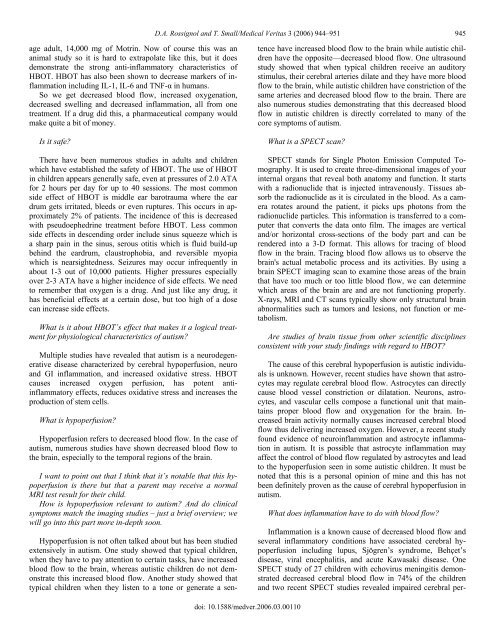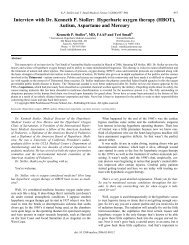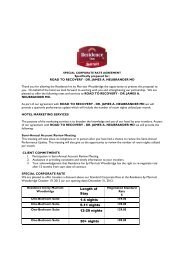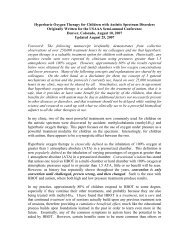Interview with Dr - Dr. Neubrander
Interview with Dr - Dr. Neubrander
Interview with Dr - Dr. Neubrander
You also want an ePaper? Increase the reach of your titles
YUMPU automatically turns print PDFs into web optimized ePapers that Google loves.
D.A. Rossignol and T. Small/Medical Veritas 3 (2006) 944–951 945<br />
age adult, 14,000 mg of Motrin. Now of course this was an<br />
animal study so it is hard to extrapolate like this, but it does<br />
demonstrate the strong anti-inflammatory characteristics of<br />
HBOT. HBOT has also been shown to decrease markers of inflammation<br />
including IL-1, IL-6 and TNF-α in humans.<br />
So we get decreased blood flow, increased oxygenation,<br />
decreased swelling and decreased inflammation, all from one<br />
treatment. If a drug did this, a pharmaceutical company would<br />
make quite a bit of money.<br />
Is it safe<br />
There have been numerous studies in adults and children<br />
which have established the safety of HBOT. The use of HBOT<br />
in children appears generally safe, even at pressures of 2.0 ATA<br />
for 2 hours per day for up to 40 sessions. The most common<br />
side effect of HBOT is middle ear barotrauma where the ear<br />
drum gets irritated, bleeds or even ruptures. This occurs in approximately<br />
2% of patients. The incidence of this is decreased<br />
<strong>with</strong> pseudoephedrine treatment before HBOT. Less common<br />
side effects in descending order include sinus squeeze which is<br />
a sharp pain in the sinus, serous otitis which is fluid build-up<br />
behind the eardrum, claustrophobia, and reversible myopia<br />
which is nearsightedness. Seizures may occur infrequently in<br />
about 1-3 out of 10,000 patients. Higher pressures especially<br />
over 2-3 ATA have a higher incidence of side effects. We need<br />
to remember that oxygen is a drug. And just like any drug, it<br />
has beneficial effects at a certain dose, but too high of a dose<br />
can increase side effects.<br />
What is it about HBOT’s effect that makes it a logical treatment<br />
for physiological characteristics of autism<br />
Multiple studies have revealed that autism is a neurodegenerative<br />
disease characterized by cerebral hypoperfusion, neuro<br />
and GI inflammation, and increased oxidative stress. HBOT<br />
causes increased oxygen perfusion, has potent antiinflammatory<br />
effects, reduces oxidative stress and increases the<br />
production of stem cells.<br />
What is hypoperfusion<br />
Hypoperfusion refers to decreased blood flow. In the case of<br />
autism, numerous studies have shown decreased blood flow to<br />
the brain, especially to the temporal regions of the brain.<br />
I want to point out that I think that it’s notable that this hypoperfusion<br />
is there but that a parent may receive a normal<br />
MRI test result for their child.<br />
How is hypoperfusion relevant to autism And do clinical<br />
symptoms match the imaging studies – just a brief overview; we<br />
will go into this part more in-depth soon.<br />
Hypoperfusion is not often talked about but has been studied<br />
extensively in autism. One study showed that typical children,<br />
when they have to pay attention to certain tasks, have increased<br />
blood flow to the brain, whereas autistic children do not demonstrate<br />
this increased blood flow. Another study showed that<br />
typical children when they listen to a tone or generate a sentence<br />
have increased blood flow to the brain while autistic children<br />
have the opposite—decreased blood flow. One ultrasound<br />
study showed that when typical children receive an auditory<br />
stimulus, their cerebral arteries dilate and they have more blood<br />
flow to the brain, while autistic children have constriction of the<br />
same arteries and decreased blood flow to the brain. There are<br />
also numerous studies demonstrating that this decreased blood<br />
flow in autistic children is directly correlated to many of the<br />
core symptoms of autism.<br />
What is a SPECT scan<br />
SPECT stands for Single Photon Emission Computed Tomography.<br />
It is used to create three-dimensional images of your<br />
internal organs that reveal both anatomy and function. It starts<br />
<strong>with</strong> a radionuclide that is injected intravenously. Tissues absorb<br />
the radionuclide as it is circulated in the blood. As a camera<br />
rotates around the patient, it picks ups photons from the<br />
radionuclide particles. This information is transferred to a computer<br />
that converts the data onto film. The images are vertical<br />
and/or horizontal cross-sections of the body part and can be<br />
rendered into a 3-D format. This allows for tracing of blood<br />
flow in the brain. Tracing blood flow allows us to observe the<br />
brain's actual metabolic process and its activities. By using a<br />
brain SPECT imaging scan to examine those areas of the brain<br />
that have too much or too little blood flow, we can determine<br />
which areas of the brain are and are not functioning properly.<br />
X-rays, MRI and CT scans typically show only structural brain<br />
abnormalities such as tumors and lesions, not function or metabolism.<br />
Are studies of brain tissue from other scientific disciplines<br />
consistent <strong>with</strong> your study findings <strong>with</strong> regard to HBOT<br />
The cause of this cerebral hypoperfusion is autistic individuals<br />
is unknown. However, recent studies have shown that astrocytes<br />
may regulate cerebral blood flow. Astrocytes can directly<br />
cause blood vessel constriction or dilatation. Neurons, astrocytes,<br />
and vascular cells compose a functional unit that maintains<br />
proper blood flow and oxygenation for the brain. Increased<br />
brain activity normally causes increased cerebral blood<br />
flow thus delivering increased oxygen. However, a recent study<br />
found evidence of neuroinflammation and astrocyte inflammation<br />
in autism. It is possible that astrocyte inflammation may<br />
affect the control of blood flow regulated by astrocytes and lead<br />
to the hypoperfusion seen in some autistic children. It must be<br />
noted that this is a personal opinion of mine and this has not<br />
been definitely proven as the cause of cerebral hypoperfusion in<br />
autism.<br />
What does inflammation have to do <strong>with</strong> blood flow<br />
Inflammation is a known cause of decreased blood flow and<br />
several inflammatory conditions have associated cerebral hypoperfusion<br />
including lupus, Sjögren’s syndrome, Behçet’s<br />
disease, viral encephalitis, and acute Kawasaki disease. One<br />
SPECT study of 27 children <strong>with</strong> echovirus meningitis demonstrated<br />
decreased cerebral blood flow in 74% of the children<br />
and two recent SPECT studies revealed impaired cerebral perdoi:<br />
10.1588/medver.2006.03.00110





